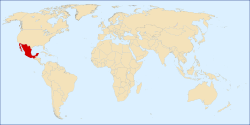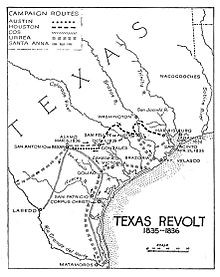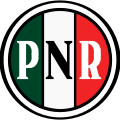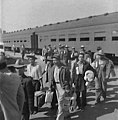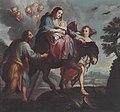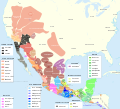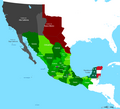Portal:Mexico
|
The Temple of Warriors at Chichen Itza, Mexico
¡Bienvenido! Welcome to the Mexico portal
Mexico, officially the United Mexican States, is a country in the southern portion of North America. It covers 1,972,550 km2 (761,610 sq mi), making it the world's 13th-largest country by area; with a population of almost 130 million, it is the 10th-most-populous country and the most populous Spanish-speaking country. Mexico is organized as a federal constitutional republic comprising 31 states and Mexico City, its capital. It shares land borders with the United States to the north, with Guatemala and Belize to the southeast; as well as maritime borders with the Pacific Ocean to the west, the Caribbean Sea to the southeast, and the Gulf of Mexico to the east.
This is a Featured article, which represents some of the best content on English Wikipedia.
The Texas Revolution (October 2, 1835 – April 21, 1836) was a rebellion of colonists from the United States and Tejanos (Hispanic Texans) against the centralist government of Mexico in the Mexican state of Coahuila y Tejas. Although the uprising was part of a larger one, the Mexican Federalist War, that included other provinces opposed to the regime of President Antonio López de Santa Anna, the Mexican government believed the United States had instigated the Texas insurrection with the goal of annexation. The Mexican Congress passed the Tornel Decree, declaring that any foreigners fighting against Mexican troops "will be deemed pirates and dealt with as such, being citizens of no nation presently at war with the Republic and fighting under no recognized flag". Only the province of Texas succeeded in breaking with Mexico, establishing the Republic of Texas. It was eventually annexed by the United States. The revolution began in October 1835, after a decade of political and cultural clashes between the Mexican government and the increasingly large population of Anglo-American settlers in Texas. The Mexican government had become increasingly centralized and the rights of its citizens had become increasingly curtailed, particularly regarding immigration from the United States. Mexico had officially abolished slavery in Texas in 1829, and the desire of Anglo Texans to maintain the institution of chattel slavery in Texas was also a major cause of secession. Colonists and Tejanos disagreed on whether the ultimate goal was independence or a return to the Mexican Constitution of 1824. While delegates at the Consultation (provisional government) debated the war's motives, Texians and a flood of volunteers from the United States defeated the small garrisons of Mexican soldiers by mid-December 1835. The Consultation declined to declare independence and installed an interim government, whose infighting led to political paralysis and a dearth of effective governance in Texas. An ill-conceived proposal to invade Matamoros siphoned much-needed volunteers and provisions from the fledgling Texian Army. In March 1836, a second political convention declared independence and appointed leadership for the new Republic of Texas. (Full article...)Selected article -Tijuana is the largest city in the state of Baja California located on the northwestern Pacific Coast of Mexico. Tijuana is the municipal seat of the Tijuana Municipality and the hub of the Tijuana metropolitan area. It has a close proximity to the Mexico–United States border, which is part of the San Diego-Tijuana metro area. Tijuana is the 47th largest city in the Americas and is the westernmost city in Mexico. According to the 2015 census, the Tijuana metropolitan area was the fifth-largest in Mexico, with a population of 1,840,710, but rankings vary, the city (locality) itself was 6th largest and the municipality (administrative) third largest nationally. The international metropolitan region was estimated at 5,158,459 in 2016, making it the third-largest metropolitan area in The Californias, 19th-largest metropolitan area in the Americas, and the largest bi-national conurbation that is shared between US and Mexico. Tijuana is the second most populous city in Mexico and center of the 6th-largest metro area in Mexico, The city is one of the fastest-growing metro areas in the country and rated as a "High Sufficiency" global city by the Globalization and World Cities Research Network. , the city of Tijuana had a population of 1,810,645, with its metropolitan area containing a population of 2,157,853 as of 2020, an estimated 2,002,000 within the urban area. (Full article...)Selected picture  Left: The Heart of Jesus (1759)
Right: The Heart of Mary (circa 1759)
image credit: public domain
This is a Good article, an article that meets a core set of high editorial standards.
Nazario Moreno González (8 March 1970 – 9 March 2014), commonly referred to by his alias El Chayo ("Nazario" or "The Rosary") and/or El Más Loco ("The Craziest One"), was a Mexican drug lord who headed La Familia Michoacana before heading the Knights Templar Cartel, a drug cartel headquartered in the state of Michoacán. He was one of Mexico's most-wanted drug lords. Very few details are known of Moreno González's early life, but the authorities believe that religion played a major role in his upbringing. Although born in Michoacán, Moreno González moved to the United States as a teenager, but fled back into Mexico about a decade later to avoid prosecution on drug trafficking charges. In 2004, the drug boss Carlos Rosales Mendoza was captured, and Moreno González, alongside José de Jesús Méndez Vargas, took control of La Familia Michoacana. Unlike other traditional drug trafficking organizations in Mexico, his organization also operated like a religious cult, where its own members were given "bibles" with sayings and conduct guidelines. Moreno González reportedly carried out several philanthropic deeds to help the marginalized in Michoacán. Such deeds helped him craft an image of protector, saint, and Christ-like messianic figure among the poor, and gave La Familia Michoacana a level of influence among some natives. (Full article...)Selected biography -Benito Pablo Juárez García (Spanish: [beˈnito ˈpaβlo ˈxwaɾes ɣaɾˈsi.a] ⓘ; 21 March 1806 – 18 July 1872) was a Mexican Liberal lawyer and statesman who served as the 26th president of Mexico from 1858 until his death in office in 1872. Of Zapotec ancestry, he was the first and only indigenous president of Mexico and the first democratically elected indigenous president in the postcolonial Americas. Previously, he had served as Governor of Oaxaca and had later ascended to a variety of federal posts including Secretary of the Interior, Secretary of Public Education, and President of the Supreme Court. During his presidency he led the Liberals to victory in the Reform War and in the Second French intervention in Mexico. Born in Oaxaca to a poor, rural, Indigenous family and orphaned as a child, Juárez passed under the care of his uncle, eventually moving to Oaxaca City at the age of 12, where he found work as a domestic servant. Sponsored by his employer who was also a lay Franciscan, Juárez temporarily enrolled in a seminary and studied to become a priest, but he later switched his studies to law at the Institute of Sciences and Arts, where he became active in Liberal politics. He began to practice law and was eventually appointed as a judge, after which he married Margarita Maza, a woman from a socially distinguished family in Oaxaca City. (Full article...)
In the news
Selected fare or cuisine -A burrito (English: /bəˈriːtoʊ/, Spanish: [buˈrito] ⓘ) in Mexico is, historically, a regional name, among others, for what is known as a taco, a tortilla filled with food, in other parts of the country. The term burrito was regional, specifically from Guanajuato, Guerrero, Michoacán, San Luis Potosí and Sinaloa, for what is known as a taco in Mexico City and surrounding areas, and codzito in Yucatán and Quintana Roo. Due to the cultural influence of Mexico City, the term taco became the default, and the meaning of terms like burrito and codzito were forgotten, leading many people to create new meanings and folk histories. In modern times, it is considered by many as a different dish in Mexican and Tex-Mex cuisine that took form in Ciudad Juárez, consisting of a flour tortilla wrapped into a sealed cylindrical shape around various ingredients. In Central and Southern Mexico, burritos are still considered tacos, and are known as “tacos de harina” (wheat flour tacos). The tortilla is sometimes lightly grilled or steamed to soften it, make it more pliable, and allow it to adhere to itself. Burritos are often eaten by hand, as their tight wrapping keeps the ingredients together. Burritos can also be served "wet", i.e., covered in a savory and spicy sauce, when they would be eaten with a fork and knife. Burritos are filled with savory ingredients, most often a meat such as beef, chicken, or pork, and often include other ingredients, such as rice, cooked beans (either whole or refried), vegetables, such as lettuce and tomatoes, cheese, and condiments such as salsa, pico de gallo, guacamole, or crema. (Full article...)
General imagesThe following are images from various Mexico-related articles on Wikipedia.
CategoriesTopicsRelated portalsWikiProjectYou are invited to participate in WikiProject Mexico, a WikiProject dedicated to developing and improving articles about Mexico. Associated WikimediaMore portals | ||||||||||




